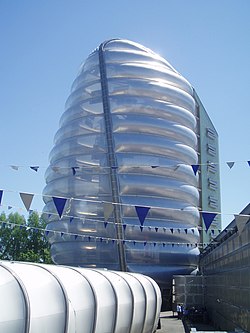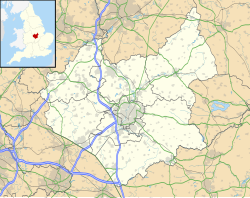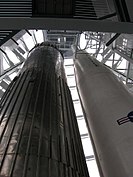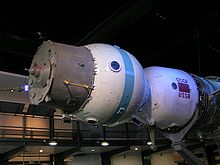
The European Space Agency (ESA) is a 22-member intergovernmental body devoted to space exploration. With its headquarters in Paris and a staff of around 2,200 people globally as of 2018, ESA was founded in 1975. Its 2024 annual budget was €7.8 billion.

The International Space Station (ISS) is the largest space station to have ever been built. The station resides in low Earth orbit and has a primary purpose of performing microgravity and space environment experiments. As implied by its name, the International Space Station is a collaboration of five space agencies and other contractors. These agencies are: NASA, Roscosmos (Russia), JAXA (Japan), ESA (Europe), and CSA (Canada).

Project Mercury was the first human spaceflight program of the United States, running from 1958 through 1963. An early highlight of the Space Race, its goal was to put a man into Earth orbit and return him safely, ideally before the Soviet Union. Taken over from the US Air Force by the newly created civilian space agency NASA, it conducted 20 uncrewed developmental flights, and six successful flights by astronauts. The program, which took its name from Roman mythology, cost $2.57 billion. The astronauts were collectively known as the "Mercury Seven", and each spacecraft was given a name ending with a "7" by its pilot.

A space suit or spacesuit is a garment worn to keep a human alive in the harsh environment of outer space, vacuum and temperature extremes. Space suits are often worn inside spacecraft as a safety precaution in case of loss of cabin pressure, and are necessary for extravehicular activity (EVA), work done outside spacecraft. Space suits have been worn for such work in Earth orbit, on the surface of the Moon, and en route back to Earth from the Moon. Modern space suits augment the basic pressure garment with a complex system of equipment and environmental systems designed to keep the wearer comfortable, and to minimize the effort required to bend the limbs, resisting a soft pressure garment's natural tendency to stiffen against the vacuum. A self-contained oxygen supply and environmental control system is frequently employed to allow complete freedom of movement, independent of the spacecraft.
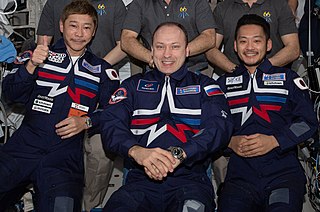
Space tourism is human space travel for recreational purposes. There are several different types of space tourism, including orbital, suborbital and lunar space tourism.

Eileen Marie Collins is a retired NASA astronaut and United States Air Force (USAF) colonel. A former flight instructor and test pilot, Collins was the first woman to pilot the Space Shuttle and the first to command a Space Shuttle mission.

Andrew "Andy" Sydney Withiel Thomas, AO is an Australian and American aerospace engineer and a former NASA astronaut. He has dual nationality; he became a U.S. citizen in December 1986, hoping to gain entry to NASA's astronaut program. He is married to fellow NASA astronaut Shannon Walker.

Peggy Annette Whitson is an American biochemistry researcher, retired NASA astronaut, former NASA Chief Astronaut, and an active Axiom Space astronaut. Whitson has a total of 675 days in space, more than any other American or woman.
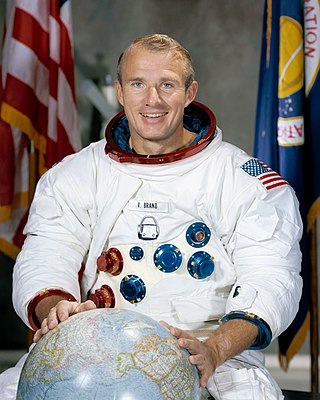
Vance DeVoe Brand is an American naval officer, aviator, aeronautical engineer, test pilot, and NASA astronaut. He served as command module pilot during the first U.S.-Soviet joint spaceflight in 1975, and as commander of three Space Shuttle missions.

Jeffrey Alan Hoffman is an American former NASA astronaut and currently a professor of aeronautics and astronautics at MIT.

The Shuttle–Mir program was a collaborative 11-mission space program between Russia and the United States that involved American Space Shuttles visiting the Russian space station Mir, Russian cosmonauts flying on the Shuttle, and an American astronaut flying aboard a Soyuz spacecraft to engage in long-duration expeditions aboard Mir.

Space Center Houston is a science museum that serves as the official visitor center of NASA Johnson Space Center in Houston. It was designated a Smithsonian Affiliate museum in 2014. The organization is owned by NASA, and operated under a contract by the nonprofit Manned Spaceflight Education Foundation, a 501(c)(3) organization. The Johnson Space Center is the home of Mission Control and astronaut training.
The British space programme is the British government's work to develop British space capabilities. The objectives of the current civil programme are to "win sustainable economic growth, secure new scientific knowledge and provide benefits to all citizens."

Major Timothy "Tim" Nigel Peake is a British author, Army Air Corps officer and European Space Agency astronaut.

The retirement of NASA's Space Shuttle fleet took place from March to July 2011. Discovery was the first of the three active Space Shuttles to be retired, completing its final mission on March 9, 2011; Endeavour did so on June 1. The final shuttle mission was completed with the landing of Atlantis on July 21, 2011, closing the 30-year Space Shuttle program.

Christina Hammock Koch is an American engineer and NASA astronaut of the class of 2013. She received Bachelor of Science degrees in electrical engineering and physics and a Master of Science in electrical engineering at North Carolina State University. She also did advanced study while working at the Goddard Space Flight Center. Just before becoming an astronaut, she served at the National Oceanic and Atmospheric Administration as station chief for American Samoa.

Artemis 3 is planned to be the first crewed Moon landing mission of the Artemis program and the first crewed flight of the Starship HLS lander. Artemis 3 is planned to be the second crewed Artemis mission and the first American crewed lunar landing since Apollo 17 in December 1972. In December 2023, the Government Accountability Office reported that the mission is not likely to occur before 2027; as of January 2024, NASA officially expects Artemis 3 to launch no earlier than September 2026.

Suzanne Mary Imber is a British planetary scientist specialising in space weather at the University of Leicester. She was the winner of the 2017 BBC Two television programme Astronauts, Do You Have What It Takes?.

The Artemis program is a Moon exploration program that is led by the United States' NASA and was formally established in 2017 via Space Policy Directive 1. The Artemis program is intended to reestablish a human presence on the Moon for the first time since Apollo 17 in 1972. The program's stated long-term goal is to establish a permanent base on the Moon to facilitate human missions to Mars.

